Top 8 Endangered Wildlife Photography in China
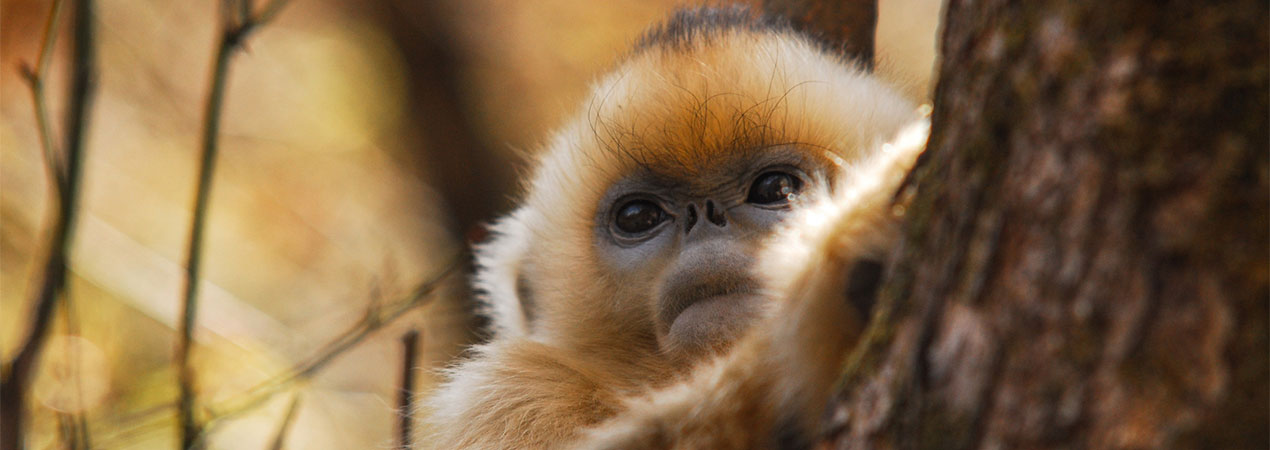
From the tops of the mountains to the depths of the oceans, humanity’s destruction of wildlife is continuing to drive many species towards extinction. The latest IUCN (The International Union for Conservation of Nature) “red list” shows that a third of all species assessed are threatened with extinction.
Human activities contribute to a loss of habitat. Development for housing, industry, and agriculture reduces the habitat of wildlife. Human activity can also lead to a loss of genetic variation. Overhunting and overfishing have reduced the populations of many animals.
Human beings are causing the greatest mass extinction of species since the extinction of the dinosaurs 65 million years ago.
Thankfully, more and more preservation programs have been established to ensure that these animals are protected, bred, and well taken care of. These preservation programs motivate and increase the awareness of the public regarding the proper management of natural resources.
Images speak louder than words in terms of wildlife protection. The protection of the pangolin is a good example. Some photographers have introduced the public to the pangolin’s life through their photos; it is a species many people had previously never heard of. That greatly promoted the public awareness of the pangolin protection. The Chinese government has removed pangolin scales from its 2020 edition of Chinese Pharmacopoeia (an official government compendium of drugs covering traditional Chinese and Western medicines) used in traditional Chinese medicine, a move campaigners describe as a "critical step" towards saving the world's most trafficked mammal.
This article aims to raise the awareness regarding the importance of wildlife and their habitat through photography tours. We shoot with a camera, not a gun.
1. Giant Panda (Ailuropoda Melanoleuca)
From being a mascot at the Olympics, to starring in Hollywood movies (Kung Fu Panda Series), the Grant Panda is a prominent character in global society, and it’s especially dear to the Chinese People. It is a national treasure. On the other hand, pandas are also honored for their peaceful and amicable nature, rarely ever attacking others.
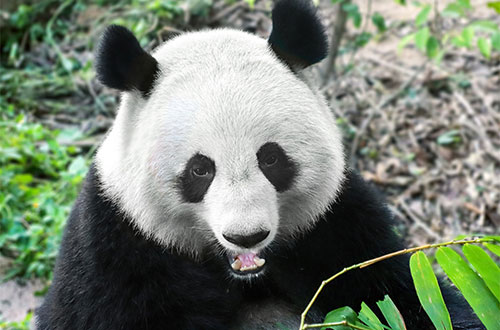
The Giant Panda only lives in a few mountain ranges in central China. Habitat destruction from industrialization and natural disasters has rendered this species endangered, with less than 2,000 left in the wild.
We recommend the following places for panda photography:
The Giant Panda Research & Breeding Center in Chengdu is the most accessible place to see this cute creature. It is only 15km from the city center of Chengdu. There are more than 80 pandas living in the base. You can also see the baby pandas if the season is right. Normally baby pandas are born in August.
The Dujiangyan Panda Base is an hour and a half outside of Chengdu. Travelers can join in their panda keeper program, you can assist caretakers in their day-to-day work, which involves waking the pandas up, cleaning the enclosures, and preparing a feast of bamboo for meals and snacks of steamed buns and apples.
Wolong National Nature Reserve is about three hours’ drive from Chengdu, it was one of the earliest nature reserves for the giant panda. The Gengda Panda Center is open to the public; its job includes education, research, captive breeding, and teaching the giant pandas how to reintegrate into their natural habitat.
2. Crested Ibis (Nipponia Nippon)
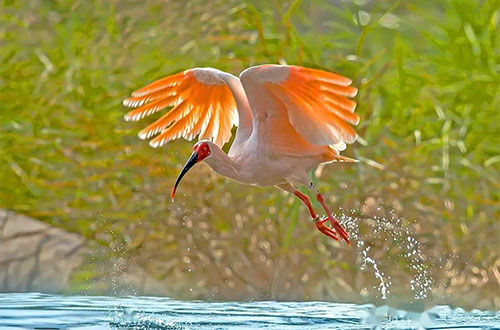
With red claws and face – plus a long and pointed beak – the crested ibis is known as the fairy bird in China. It is a revered bird in Japan, prized for its beautiful appearance, its elegance and its symbolism as a sign of good luck and happiness. They were widespread in China, the Korean peninsula, Japan and Russia until the 1960s when the widespread use of pesticides and fertilizers, plus a loss of habitat, drove the birds to near extinction. In the early 1980s, the entire species in the wild around the world was thought to be down to the last seven birds (4 adults and 3 chicks). To protect the bird, steps were taken to ensure the birds were not disturbed, with people stationed near the tree to prevent attacks by other animals. Farmers were also banned from using fertilizers and pesticides at the nearby farm for fear of poisoning the birds. A ban was also placed on any work using explosives in local mines in case it scared the birds away. Today, the number of crested ibises in China has burgeoned to more than 2,000, including both artificially bred birds and those born in the wild. Half those numbers are now living in natural habitats, with ibises released from captivity and those born in the wild dispersed throughout the 15,000 square kilometers of Shaanxi Province. The area where the birds were initially found became the site of the first crested ibis conservation station in China. Now it is called Shaanxi Hanzhong Crested Ibis National Nature Reserve in northwestern China’s Shaanxi Province.
3. Golden Snub-nosed Monkey (Rhinopithecus Roxellana)
The Golden Snub-nosed Monkey (or Sichuan Snub-nosed Monkey) is endemic to China, where they were found in a very small region in the mountainous forests. The monkey is covered in long, thick fur, allowing it to better withstand colder temperatures than other non-human primates, and it is well adapted for the snowy, mountainous forests it inhabits at about 3000 metres (9843 ft) above sea level. They live in groups of one male and several females and spend most of their time up in trees, eating leaves, bark and lichens. There are three other subspecies of the snub-nosed monkey, all living in a similar range and habitat, and all are classified as endangered.
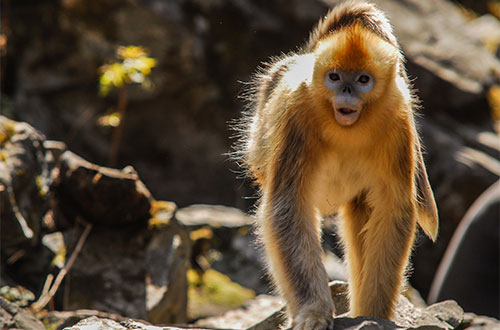
Golden snub-nosed monkeys have experienced a 50 percent population decline in the past 40 years. Threats to the monkey started far longer ago, however, as it was thought that the fur of the species had medicinal properties and it was widely hunted. Today, that practice has more or less ceased, although some illegal hunting for their meat does still occur. Now the species is most threatened by degradation and loss of habitat. Its preferred food source, lichens, grows in abundance on the bark of dead trees and those trees are now harvested instead of being left in the forest. While the species occurs in a number of protected areas, it is still losing its habitat at a rate steady enough for it to be at great risk of extinction.
To photograph Golden Snub-nosed Monkeys, the best place is Foping National Nature Reserve in Shaanxi Province, northwestern China. There is a research station called Monkey Valley where scientists are studying the behavior of the monkeys. In order to carry out their studies, the scientists feed the monkeys with corn and apples twice a day.
4. Père David's Deer (Elaphurus Davidianus)
Père David’s deer was called ‘milu’ in China, which is their native country. They are known as "sibuxiang," or "like none of the four,” because they have “the hooves of a cow but not a cow, the neck of a camel but not a camel, the antlers of a deer but not a deer, the tail of a donkey but not a donkey.”
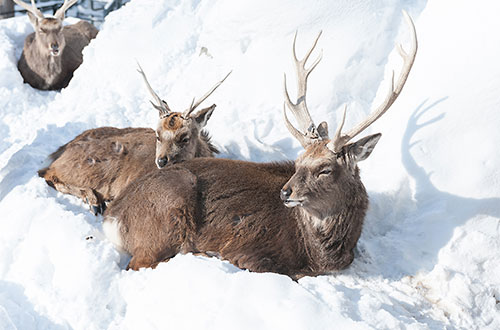
The deer had roamed China's marshlands for thousands of years until the middle of the 19th century, but now the only herd of milu in the world was found in the emperor ’s walled hunting preserve in south of Beijing. The number of milu deer living in the wild waned due to loss of habitat, before finally dying out in 1900 in the hunting grounds, which were flooded and then overtaken by soldiers from the eight nations, brought in to suppress the Boxer Rebellion, and who slaughtered the deer for food.
Père David’s got their name from Father David, the man who saved them (‘père’ means “father” in French). Father David managed to smuggle a few out of China, enabling it to make its way into European zoos. With the help of zoos, the Duke of Bedford, and hunting ranches, their numbers have been growing ever since. In 1985, 20 animals were reintroduced to China, and after some four decades the population had grown to 7,000.
The Beijing Nanhaizi Milu Park is the most accessible place to see the deer. The park is the former hunting preserve for royal family.
Dafeng Milu National Nature Reserve in eastern China's Jiangsu Province has the largest population of milu. It was established 1986, the first herd of deer are 42 from the UK. With the efforts of staff in the reserve, the number of local milu has increased to 5681, including 1820 wild ones.
5. Black-necked Crane (Grus Nigricollis)
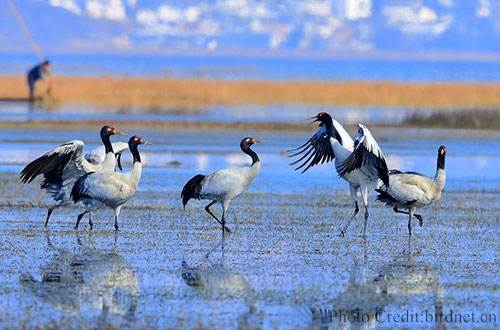
Black-necked Cranes, the only alpine crane, were the last species of crane discovered and described by ornithologists in 1876 due to the remoteness of their habitat.
It is endemic to the Tibetan Plateau in China. In summer, the black-necked crane is found at extremely high elevations, typically 3000-4900 m (9840-16079ft), on the central and northern Tibetan Plateau where it nests in high altitude wetlands throughout Qinghai and the northern Tibet Autonomous Region as well as in adjacent areas of Xinjiang, Gansu, western Sichuan, and the Ladakh region of India. In winter, the black-necked crane migrates south to the valleys of the Yarlung Tsangpo River and its major tributaries in the south-central Tibet Autonomous Region, northeast and northwest Yunnan and western Guizhou.
Caohai National Nature Reserve in Weining County, southwestern China’s Guizhou Province is one of the wintering locations of the black-necked cranes. Staff members of the nature reserve have planted vegetables, such as carrots, potatoes and cabbage, to help the birds get through winter. There are seven main habitats of black- necked cranes in the nature reserve, and those who have arrived have mainly gathered at the wetlands and swamps on the east, south and southwest. Latest research shows that more than 800 black-necked cranes are now there.
6. Brown Eared-pheasant (Crossoptilon Mantchuricum)
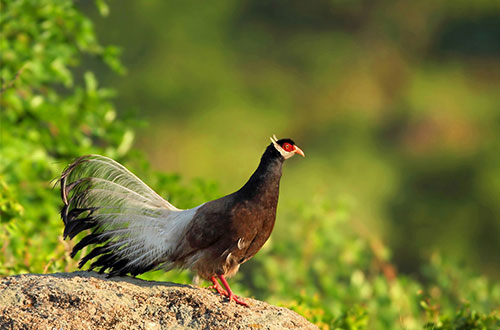
Brown Eared Pheasants are endemic to China. They are now found at scattered localities in the Lvliang Shan Mountains of western Shanxi, and the mountains of north- western Hebei, western Beijing and central Shaanxi. They live mostly in sub alpine forests above 1200m (3937ft). Like the other eared pheasants they have very powerful beaks which they use to dig up roots. They will also eat leaves, shoots, seeds, insects and worms.
Its hair-like and beautiful glossy brown plumage is very ornamental. Its tail feathers were used to decorate the general’s helmet in Ancient times. According to the beliefs of the ancient Chinese, the feathers of this amazing bird bring courage to their owner. Several protected areas have been established for the conservation of this species and its habitats in Shanxi, Shaanxi and Hebei.
Xuanzhong Temple in northern China’s Shanxi province is the best-known place to view the Brown Eared Pheasant. The birds there are semi-wild, and local people feed them daily.
7. White-headed Langur (Trachypithecus Leucocephalus)
The white-headed langur is native to China and it is one of the most endangered primates in the world. It was listed as a protected animal of the first degree under the Wild Animal Protection Law of China. There were fewer than 300 of them left in China in the 1980s. A series of actions to protect the rare animal has been launched at the Chongzuo National Nature reserve. Its population has now reached around 1300.
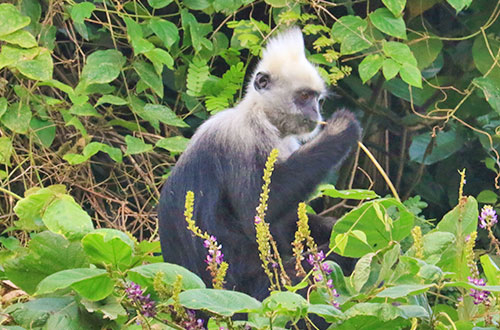
White-headed langurs only live in the limestone karst hills area between the Zuojiang River and its tributary Mingjiang River in south China's Guangxi Zhuang Autonomous Region. They rest in the karst caves during the night and leap across the woods feeding on plant leaves and fruits during the day. In Chinese, they were known as leaf monkeys because of their vegetarian diet. They live much like a big family with one adult male and several adult females in a group, caring for their infants together. Chongzuo National Nature Reserve, located in southern China's Guangxi Zhuang Autonomous Region is the only place you can find them.
By the way, other highlights in the vicinity are Zuojiang Huashan cliff paintings and Detian Waterfall. The Zuojiang Huashan cliff paintings are a UNESCO World Heritage Site and one of the largest cliff paintings in all of China. Detian Waterfall is the largest transnational waterfall in Asia. The waterfall is shared by both China and Vietnam.
8. Golden Takin (Budorcas Taxicolor Bedfordi)
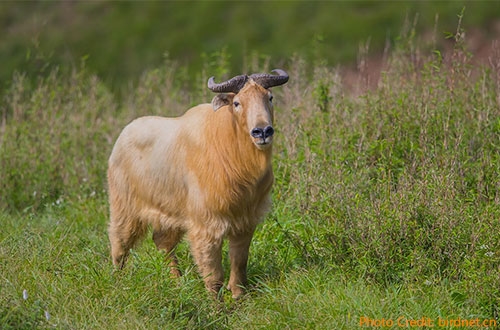
The golden takins mainly live in the Qinling Mountains in central China’s Shaanxi province; their coats are golden in color. They have sturdy hooves and strong legs that help them keep their footing on rugged ground. Their thick wool keeps them warm in winter months. Populations have been declining in recent years due to habitat loss and hunting. They are under first-class protection in China. They can be found at a variety of altitudes ranging from 1,000 to 4,500 meters. Takins feed on various leaves and grasses, bamboo shoots and flowers, and early mornings and late afternoons are their favorite time to graze. Most of the takins live in herds, and each band has a guard which gives the group a cough alarm when disturbed.
Niubeiliang Nature Reserve is the only reserve for golden takin protection. Niubeiliang, with an elevation of 2,802 m (9193ft), is the highest peak of the eastern segment of Qinling Mountains. About 350 golden takins now live here.
For wildlife photography, it takes knowledge, patience, and lots of luck to get a good picture. Here are three tips:
1. Buy a Good Camera
There are many types of cameras out there, but only a few are versatile enough for shooting wildlife outdoors. A common camera constantly exposed to harsh elements will not last very long, so you need a camera that’s weather-sealed. Although the extra protection makes it more expensive, knowing that it can perform in different conditions is enough reason to invest in it.
2. Improve Your Photographic Skills and Technique.
Before you set out in the woods with your camera, practice shooting little critters in your neighborhood, you can improve your skills at your local zoos or even your backyard.
3.Study the Animals You’ll Be Going to Photograph
The best way to increase your chances of capturing great shots is by studying your subjects. Before you go out, study the animals you want to photograph.

OR
Are you eager to begin your Chinese cultural journey?
Drop us a line and we will promptly connect you with our leading China expert!
 Top 6 Places for Architecture Photography
Top 6 Places for Architecture Photography  Top 10 Guilin Photography Locations
Top 10 Guilin Photography Locations  Silk Road Photography Tour
Silk Road Photography Tour 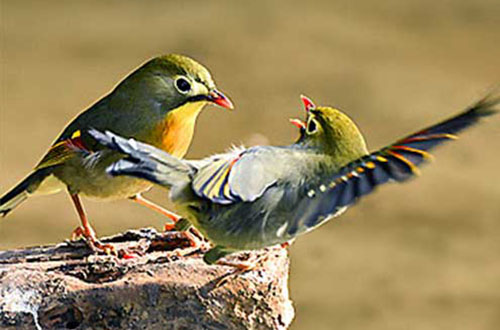 Birding Tour in Eastern China
Birding Tour in Eastern China